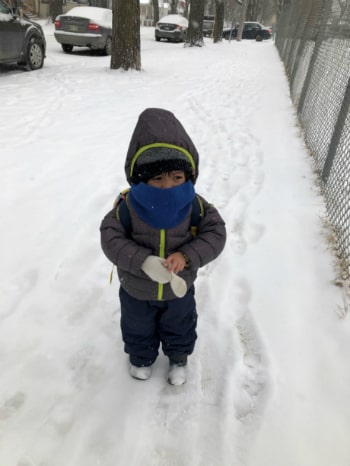Walking my kids to school every day, even during the winter, has taught me to always be mindful of the temperature outside. However, when something is done daily, it becomes routine, and complacency can set in. This is how I learned about frostbite in an unpleasant and scary way.

It was New Year’s Eve, and like previous years, we decided to see the fireworks. The temperature was around -29°C with a -35°C wind chill. The night quickly turned into a nightmare.
While watching the fireworks, I noticed that my 3-year-old son Kai was not behaving like his usual active self. He started complaining that his legs hurt. We took him to a shelter and tried wrapping him in blankets to keep him warm. When it didn’t seem like it was working, and he kept on crying, I became frantic and felt helpless. My husband then noticed that Kai’s legs were purplish. We put warm towels on his legs and gave him warm water.
This process felt endless. Finally, Kai responded well and what could have been much worse was avoided. But the feeling from that nerve-wracking experience never ended for me.
After the frostbite experience with my son, I swear by the Canadian Red Cross website and First Aid app for cold weather safety tips.
I learned that covering the head and trunk by wearing a hat, putting on layers of tightly woven fabrics like wool or synthetic, and covering all exposed areas: nose, ears, cheeks and fingers will provide protection from the dangers of hypothermia and frostbite.
Frostbite is a serious condition in which body tissues freeze. It happens most often in the fingers, toes, ears, and nose. It often starts as skin that is paler than usual and then progresses to a white, blue or mottled appearance.
If this happens, you can help by:
- Getting the person away from the cold and into shelter.
- Removing any wet clothing or anything that may restrict blood flow to the area.
- Do not rub areas that appear to be affected by frostbite.
- Thaw the area only if you are sure it will not freeze again using warm (not hot) water or body heat.
- Protect the skin with loose, dry dressings. Place gauze between fingers or toes if they are affected. Leave any blisters intact.
- If possible, elevate any thawed extremities above the level of the heart.
- Rehydrate the person by providing plenty of fluids.
- Encourage the person to seek medical attention.
In case they come in contact, pour warm water on the surface of the object or the skin that is stuck, then slowly help release the skin from the object. Treat other possible injuries and comfort the person. Call 911/EMS if you cannot safely remove the body part from the metal object.
Prevention and knowledge are key to protect you and your loved ones from harm this winter. Be aware of the temperature outside and know the risks that come with it.

